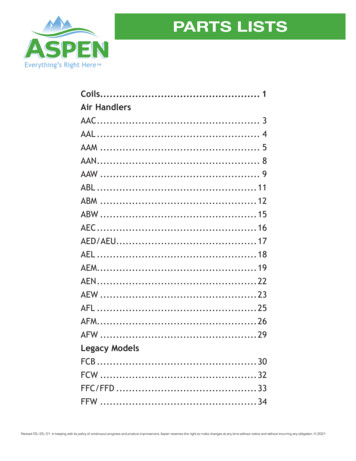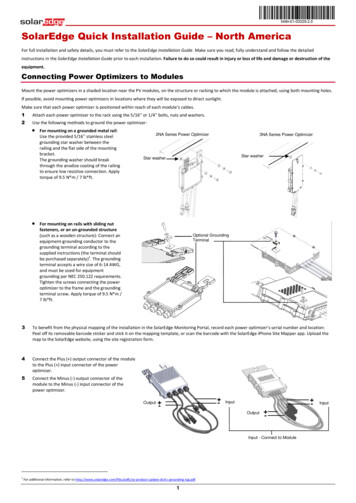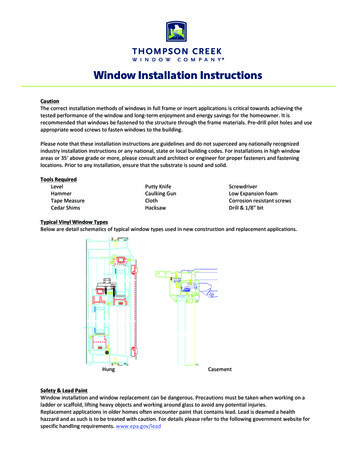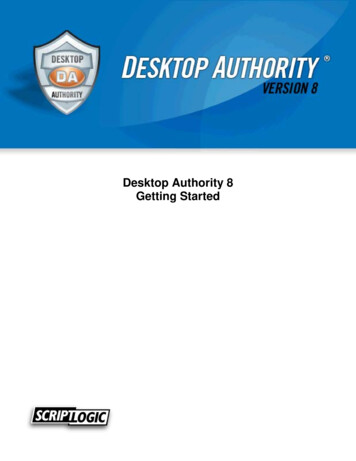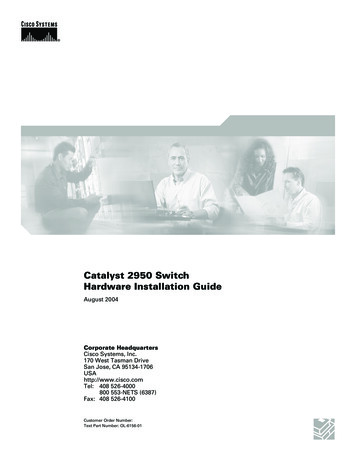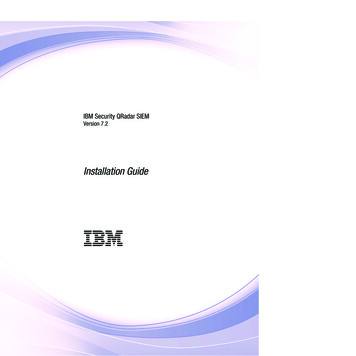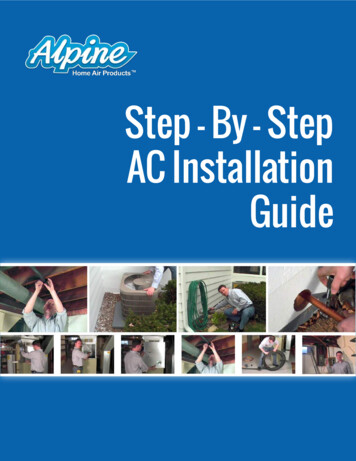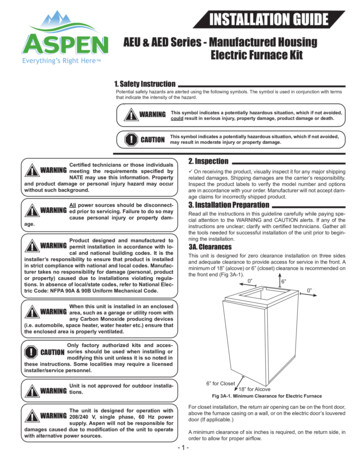
Transcription
INSTALLATION GUIDEAEU & AED Series - Manufactured HousingElectric Furnace Kit1. Safety InstructionPotential safety hazards are alerted using the following symbols. The symbol is used in conjunction with termsthat indicate the intensity of the hazard. !WARNINGThis symbol indicates a potentially hazardous situation, which if not avoided,could result in serious injury, property damage, product damage or death.!CAUTIONThis symbol indicates a potentially hazardous situation, which if not avoided,may result in moderate injury or property damage.2. InspectionCertified technicians or those individualsWARNING meeting the requirements specified byNATE may use this information. Propertyand product damage or personal injury hazard may occurwithout such background.!!WARNINGage.ü On receiving the product, visually inspect it for any major shippingrelated damages. Shipping damages are the carrier’s responsibility.Inspect the product labels to verify the model number and optionsare in accordance with your order. Manufacturer will not accept damage claims for incorrectly shipped product.3. Installation PreparationAll power sources should be disconnected prior to servicing. Failure to do so maycause personal injury or property dam-Read all the instructions in this guideline carefully while paying special attention to the WARNING and CAUTION alerts. If any of theinstructions are unclear; clarify with certified technicians. Gather allthe tools needed for successful installation of the unit prior to beginning the installation.Product designed and manufactured topermit installation in accordance with local and national building codes. It is theinstaller’s responsibility to ensure that product is installedin strict compliance with national and local codes. Manufacturer takes no responsibility for damage (personal, productor property) caused due to installations violating regulations. In absence of local/state codes, refer to National Electric Code: NFPA 90A & 90B Uniform Mechanical Code.!WARNING3A. ClearancesThis unit is designed for zero clearance installation on three sidesand adequate clearance to provide access for service in the front. Aminimum of 18” (alcove) or 6” (closet) clearance is recommended onthe front end (Fig 3A-1).0”6”0”When this unit is installed in an enclosedarea, such as a garage or utility room withany Carbon Monoxide producing devices(i.e. automobile, space heater, water heater etc.) ensure thatthe enclosed area is properly ventilated.!WARNINGOnly factory authorized kits and accessories should be used when installing ormodifying this unit unless it is so noted inthese instructions. Some localities may require a licensedinstaller/service personnel.!!CAUTIONWARNING6” for ClosetUnit is not approved for outdoor installations.18” for AlcoveFig 3A-1. Minimum Clearance for Electric FurnaceFor closet installation, the return air opening can be on the front door,above the furnace casing on a wall, or on the electric door’s louvereddoor (If applicable.)The unit is designed for operation withWARNING 208/240 V, single phase, 60 Hz powersupply. Aspen will not be responsible fordamages caused due to modification of the unit to operatewith alternative power sources.!A minimum clearance of six inches is required, on the return side, inorder to allow for proper airflow.1
3B. Closet and Alcove Installation!CAUTION3B-2. AED-001 (Front Return Only) ConfigurationMount coil cabinet on top of electric furnace and secure both unitwith the Alignment Plates (Figure 3B-2). There are pre-holes oncoil cabinet but you will need to self-drill onto the electric furnace tosecure plates. Mount the Louver Single Door to finalize assembling.See section 5 for more information on easily aligning the single dooronto the final assembly. Unit is not field-configurable into upfloworientation without separate solid door and convertible coil cabinet.Ensure that the unit is adequately sized.The tonnage of the outdoor unit shouldnever exceed the tonnage of this unit.These units are designed to be installed in a closet or an alcove.If installing the electric furnace into a closet or an alcove, the unitmust leave front clearance to service the unit. The bottom of the unitshould also rest on a sturdy platform or floor.Wall MountReturn Air GrilleFigure 3B-2 (Filter Size: 18x20x1)Fig 3B. Closet Installation3B-3. AED-000 Downflow (Top Return) &AED-002 Downflow (Top/Front):Airflow must be made available to the electric furnace’s return. Notdoing so may cause improper heating as well as premature heatingelement failure.Mount coil cabinet on top of electric furnace. Secure both unitswith the Alignment Plates (Figure 3B-3). There are pre-holes oncoil cabinet but you will need to self-drill onto the electric furnaceto secure plates. Mount the louvered door to finalize assembling fortop/front return; for the AED-000, a separate solid door is required.See section 5 for more information on easily aligning the single dooronto the final assembly.3B-1. AEU-000 ConfigurationMount electric furnace onto the coil cabinet (if shipped in downflowconfiguration, refer to section 4 for cabinet reconfiguration) andsecure with Alignment Plates on each side (see Figure 3B-1). Seesection 5 for more information on easily aligning the single door ontothe final assembly.Figure 3B-1 (Filter Size: 18x20x1)Figure 3B-3 (Filter Size: 18x20x1)2
3B-4. AEU Coil Cabinet Reconfiguration3B-5. Filter CareStep 1: On the electric furnace, self-drill Door Hook (Item D) on topof the electric furnace. See Figure 3B-4AThe filter should be checked every month. You may replace the filterby simply removing single door and sliding out the existing one toreplace with a new filter.Filter Size:18x20x1Figure 3B-4AFigure 3B-5Step 2: Configuring coil box, remove filter from top/front return configuration (Figure 3B-4B) and insert on bottom of the cabinet for filtering return air (Figure 3B-4C).3B-6. Door MountingWhen installing the single door onto the final assembly of AEU orAED follow these steps: While standing in front of AEU or AED, insert bottom flange at anangle into the unit. See Figure 3B-6A. Lift the top of the single door into the Door Hook / Top Bracket(v-feature) at upright position to slowing slide down the door intofeature. See Figure 3B-6B.Top/Front Return (Before)Figure 3B-4BFigure 3B-6AFigure 3B-6B3C. Ductwork and Duct ConnectorDuct systems should be installed in accordance with standards forair-conditioning systems, National Fire Protection Association Pamphlet No. 90A or 90B. They should be sized in accordance with National Environmental System Contractors Association Manual K, orwhichever is applicable. It is recommended that installers refer tothe “Manufactured Housing Duct System Guide to Best Practices”by MHI-MHRA.Filter U-Retainerdesign allowsfilter to be easilyreplaced whenneeded.On any job, non-flammable flexible collars should be used for thereturn air and discharge connections to prevent transmission of vibration. Although these units have been specially designed for quiet,vibration-free operation, air ducts can act as soundboards if poorlyinstalled.Bottom Return (After)Figure 3B-4CAll main supply and return air drops should be properly sized asdetermined by the designer of the duct system and should not necessarily be the size of the duct flange openings of the unit. (The ductsize should never be smaller than the flange openings of the electricfurnace supply and return air openings.)To install the duct connector:- Attach duct connector foam gasket along the perimeter of the ductopening to seal the duct connector to the top of the duct.- To connect the duct connector, insert it into the floor opening andbend back the tabs inside the duct. Fold the tabs over 90 degrees toensure a secure connection. Seal around the duct connector.Upflow Re-ConfigurationFigure 3B-4D- Slit the corners of the duct connector that stick up above the floor,and then bend the sides over onto the floor surface.3
5. Low Voltage Connections- Insulate between the floor base and the floor when used on a combustible floor. Be sure to cut the insulation around the perimeter ofthe duct connector opening.5A. Single Stage Cooling with Electric HeatThe electric furnace comes factory setup for a single stage cooling system. If factory installed accessory electric heaters are preinstalled, the unit will also have a low voltage wire for the electric heat(Fig 5A-1).- Install the floor base over the floor opening with the flanges on the11 x 13 inch opening facing down.- Use four screws to secure the floor base to the floor.It is recommended that wherever supply and return air sheet metalducts pass through unconditioned areas, they be insulated to prevent excessive heat loss during heating operation. When applied inconjunction with summer air conditioning, sheet metal duct routedthrough unconditioned areas should be insulated and have an outside vapor barrier to prevent formation of condensation.4. Electrical Line Voltage WiringThese units are designed for single or three phase 208/240 volts, 60HZ power supply. Wire selection and wiring must be in accordancewith the National Electric Code and/or local codes. Unit terminals aredesigned to accommodate copper and aluminum wiring. If aluminumwiring is used: please observe special precautions relative to sizing,wire connections and corrosion protection.Fig 5A-1.During cooling mode operation, the indoor blower G wire will energize a time delay relay inside the electric furnace. After a short timedelay period, the time delay relay contacts will close and apply powerto the blower motor. Fan delay periods are 7 seconds ON delay and65 seconds OFF delay. (See Schematic)The Y wire from the thermostat is not connected at the electric furnace. This wire goes directly to the outdoor unit 24 volt wiring to turnon the outdoor condensing unit when a call for cooling takes place.The 24 volt common for the outdoor unit circuits is connected at theelectric furnace Brown wire.The electric heater low voltage wiring W terminal is wired directlyfrom the thermostat to the electric furnace. The blower will delay aheat call ON for a period of 5 seconds. The OFF delay period is 60seconds.All models with 5,8 or 10 kW electric heat are arranged for singlecircuit connections. Models larger than 10 kW are arranged for multicircuit protection. Refer to top part of wiring diagram at the end of thisguide for detailed information.Line voltage wiring should berouted through the access holesat the top of the electric furnace. Proper electrical conduitconnection fittings should beused. Connect the power wiringto the line side connections onthe electric furnace. The electrical ground wire should be connected to the grounding lug.Ensure both the field suppliedground wire and electric furnaceGREEN ground wire are bothsecured to the grounding lug ofthe electric furnace.208VACTap240VACTapIf the line voltage being supplied to the electric furnace is208 volt single phase, the linevoltage tap on the low voltagetransformer needs to be movedfrom the 240 volt tap to the 208volt tap. If this is not done, thesecondary output voltage of thetransformer will be too low.Fig 5A-2.4
6. Air Volume Adjustment8. Adjustment Of Heat AnticipatorAfter all connections are made, start-up and checkout must be performed before proper evaluation of the entire system can be made.Make sure that heat anticipator is properly set as noted on thermostat instructions. Load requirements can vary in each residence andit may be necessary for the installer or homeowner to make slight adjustments to the heat anticipator setting for longer or shorter cycles.It is recommended to change the setting no more than plus or minus0.05 amps at a time. Greater changes can cause the unit to rapidcycle or remain on excessively. Measure anticipator circuit currentwith electric heaters energized and set anticipator to proper level.Air volume needs to be set to the level recommended by the outdoorunit equipment manufacturer. Most systems will require around 400CFM of indoor air for every 1 ton of system cooling capacity. The airvolume must be set prior to attempting system charge.This electric furnace uses a 240V PSC motor. The air volume levelproduced by the electric furnaces at varying external static pressurelevels is shown in Table D)T1T2T3T4T53/45.4240CFM V. EXTERNAL 506408851127126016509. Final System Checkout1. Make certain all cabinet openings are properly sealed and anygrommets moved during installation are moved into proper place.Table 6-1.2. With cooling system operating, check for condensate leakage.Use a Magnehelic Gauge with a 1” scale and two static pressuretips to measure the static pressure during the air volume adjustmentprocedure. The high port static pressure tip should be placed in thesupply duct near the outlet of the electric furnace. The low port staticpressure tip should be placed in the return air duct near the entranceto the electric furnace. The factory provided air filter should be inplace inside of the electric furnace.3. Perform leak detection inspection of refrigerant circuit and connecting piping.4. Secure all cabinet doors1. Select a starting speed tap from the CFM table.2. Call for fan only operation at the thermostat.3. Read the external static pressure level on the Magnehelic gauge.4. Make speed tap selection changes to get the air volume as closeas possible to the required level.5. If the static pressure is above .5” wc , excessive turbulence or ductfriction needs to be reduced. (Obstructions in the duct system canalso cause excessive static pressure.)6. When proper air volume is established, move on to the chargingprocedure.7. System ChargingAn improperly charged system may causedegradation in system performance anddamage the compressor. After installationof the coil, refer to the outdoor unit manufacturer for chargingtechniques and amount of charge. If outdoor unit manufacturerscharging instructions are unavailable; then refer to instructionsbelow to charge the system.!CAUTION1. Bring airflow up to the maximum CFM possible according to Table6-1.2. Evacuate refrigeration system to micron level required by outdoorunit manufacturer.3. Release system charge from outdoor unit and call for cooling.4. Use outdoor unit equipment manufacturer specific charging chartsif available and make proper charge adjustment based upon outdoorunit instructions.5. If outdoor unit instructions and charts are not available, use Aspenprovided charts. Make certain indoor air temperature is near comfortlevel setpoint 75F, prior to establishing superheat and subcoolinglevels.5
6HSBK/WHS HS5LCHTR 1224 VOLTSX13EMLCLCHTR 3HTR 2LCLCHTR 5HTR 4LCHTR 63208-240 VOLTS14NCBTDCOMCBNOHSHSHSRHIGH VOLTAGE disconnect all power sources prior to servicing. Failure might lead to safety hazardBR GN WBTDHSHSHSCBCURRENT 8/17/1810. Wiring diagram for AEU/AED models
373 Atascocita Rd.Humble, TX 77396Phone: 281.441.6500Toll Free: 800.423.9007Fax: 281.441.6510www.aspenmfg.comRevised 05-01-20. Subject to change without notice and without incurring obligation. Copyright 2020 Aspen Manufacturing. All Rights Reserved7
3B-3. AED-000 Downflow (Top Return) & AED-002 Downflow (Top/Front): Mount coil cabinet on top of electric furnace. Secure both units with the Alignment Plates (Figure 3B-3). There are pre-holes on coil cabinet but you will need to self-drill onto the electric furnace to secure plates. Mount the louvered door to finalize assembling for
